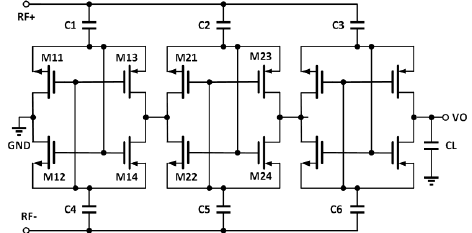[moved] Fully Cross-Coupled Rectifier Configuration in Terms of Transistor Terminals
I'm currently designing a rectifier to be used for our RF energy harvester. Along the way, I found out that the fully cross-coupled configuration is the reference design of the latest rectifier designs. I was confused though of the correct connection of the terminals of the rectifying transistors, particularly the Source and Drain terminals. I researched and found these two figures which have different connection of the transistor terminals, though it may looked the same at a quick look. My question is, which of these is right?
Thank you so much for all your help.

Operations of this rectifier are explained by source as RF input.
On this meaning, https://www.edaboard.com/attachment....7&d=1528895274 is appropriate.
However consider area of source and drain in multi finger configuration.
I recommend smaller area terminal should be connected to RF input.
Generally I call smaller area terminal drain.
And if we consider where body of MOS FET is connected, https://www.edaboard.com/attachment....9&d=1528895295 is appropriate.
In these two meanings, I prefer https://www.edaboard.com/attachment....9&d=1528895295
However both are right.
If MOS FET is a single gate type and has no offset for drain, there is no difference between source and drain.
Thanks for your response pancho_hideboo.
By the way, another question. How can source and drain differs in area in multi-finger configuration? How is drain or why can you say that the drain is the smaller area terminal?
Thanks again in advance. :)
Surely read very basic text book.
Drain is hot node, on the other hand, Source is cold node in many application.
pancho_hideboo, thanks for the reply. By the way, is there any reference or text book you can refer me to read?
[QUOTE=Drain is hot node, on the other hand, Source is cold node in many application.[/QUOTE]
I tried searching for the drain being the hot node and source being the cold node but I can't any reference of help. Is there any reference you can also recommend with these?
Thanks you so much pancho_hideboo. I did really learned a lot of new stuffs from you. :)
https://www.amazon.com/exec/obidos/t...glance&s=books
Consider behavior of drain and source in common source amplifier.
